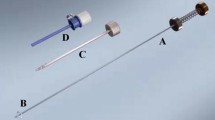Abstract
The reported incidence of intraoperative retained instruments, such as needles, hangs around 0.06–0.11%. Leaving a needle inside the abdominal cavity can have significant medical and legal consequences. In addition, the retrieval can be hampered due to the limited visualization of the scope during minimally invasive surgery. Factors associated with an increased probability for NL have been described. Prevention for this situation includes: having one needle at a time inside the cavity, effective communication between all personnel in the operating room, evaluation of the strength of the suture–needle connection, avoid parking of needles intraoperatively, and a proper needle withdrawal. Notwithstanding, no agreement has been made regarding NL management. Herein, we present a literature review, and a management proposal in which through a series of systematic steps, the surgical team can efficiently locate and retrieve a lost needle such as: examination of the surgical field, trocar visualization, trocar disassembly, and revision of the suction device. Finally, intraoperative or postoperative imaging can be utilized.


Similar content being viewed by others
References
Sánchez A, Sotelo R, Rodriguez O, Sánchez R, Rosciano J, Medina L et al (2016) Robot-assisted video endoscopic inguinal lymphadenectomy for melanoma. J Robotic Surg 10(4):369–372
Small AC, Gainsburg DM, Mercado MA, Link RE, Hedican SP, Palese MA (2013) Laparoscopic needle-retrieval device for improving quality of care in minimally invasive surgery. J Am Coll Surg 217(3):400–405
Jayadevan R, Stensland K, Small A, Hall S, Palese M (2014) A protocol to recover needles lost during minimally invasive surgery. JSLS Soc Laparoendosc Surg 18(4):e2014.00165
Barto W, Yazbek C, Bell S (2011) Finding a lost needle in laparoscopic surgery. Surg Laparosc Endosc Percutan Tech 21(4):e163–e165
Gawande AA, Studdert DM, Orav EJ, Brennan TA, Zinner MJ (2003) Risk factors for retained instruments and sponges after surgery. N Engl J Med Mass Med Soc 348(3):229–235
Zaman S, Clarke R, Schofield A (2015) Intraoperative loss of a surgical needle: a laparoscopic dilemma. JSLS Soc Laparoendosc Surg 19(2):e2013.00401
Smith BM, Brown RA, Lobe TE (1993) The lost needle: a laparoscopic dilemma. J Laparoendosc Surg 3(4):425–426
Sotelo RJ, Haese A, Machuca V, Medina L, Nuñez L, Santinelli F et al (2016) Safer surgery by learning from complications: a focus on robotic prostate surgery. Eur Urol 69(2):334–344
Sharma AP, Mete UK, Bendapuddi D, Bora GS, Mavuduru RS (2017) Needle in a haystack: lost in transition. J Robotic Surg 21(4):163
Gibbs VC (2011) Retained surgical items and minimally invasive surgery. World J Surg Springer-Verlag 35(7):1532–1539
Ponrartana S, Coakley FV, Yeh BM, Breiman RS, Qayyum A, Joe BN et al (2008) Accuracy of plain abdominal radiographs in the detection of retained surgical needles in the peritoneal cavity. Ann Surg 247(1):8–12
Ariz C, Horton KM, Fishman EK (2004) 3D CT evaluation of retained foreign bodies. Emerg Radiol Springer-Verlag 11(2):95–99
Ostrzenski A (1997) An intraoperative method of localizing a missing piece of a broken laparoscopic instrument. Am J Obstet Gynecol 176(3):726–727
Omar MA, Davidson A, Karim OMA (2012) Lost needle: a dilemma in robotic-assisted laparoscopic surgery. J Robotic Surg 6(1):73–75
Jiménez S, Micó MM, Arnaldos M, Medina F, Contreras S (2018) State of the art of produced water treatment. Chemosphere 192:186–208
Funding
This study was not funded by any institution.
Author information
Authors and Affiliations
Corresponding author
Ethics declarations
Conflict of interest
Authors Medina L. G, Martin O, Cacciamani G. E, Ahmadi N, Castro J. C, and Sotelo R declare that they have no conflict of interest.
Ethical approval
All procedures followed were in accordance with the ethical standards of the responsible committee on human experimentation (institutional and national) and with the Helsinki Declaration of 1975, as revised in 2000 [5]. Informed consent was obtained from all patients for being included in the study.
Rights and permissions
About this article
Cite this article
Medina, L.G., Martin, O., Cacciamani, G.E. et al. Needle lost in minimally invasive surgery: management proposal and literature review. J Robotic Surg 12, 391–395 (2018). https://doi.org/10.1007/s11701-018-0802-9
Received:
Accepted:
Published:
Issue Date:
DOI: https://doi.org/10.1007/s11701-018-0802-9




